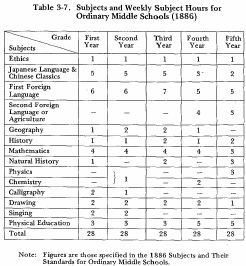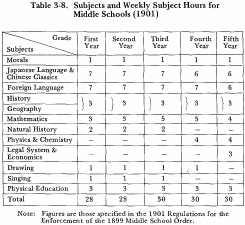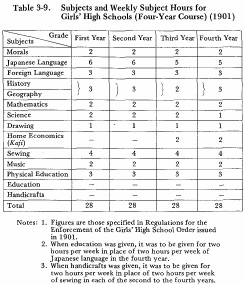- 現在位置
- トップ > 白書・統計・出版物 > 白書 > JAPAN'S MODERN EDUCATIONAL SYSTEM > (2)The Implementation of a Textbook Authorization System
(2)The Implementation of a Textbook Authorization System
During the tenure of Education Minister Mori Arinori, the central government's control over education strengthened, and a system of state authorization of textbooks gradually proceeded to realization. This authorization system was not only for elementary school textbooks but also applied to normal school and middle school textbooks. But, in those days, as only a small number of textbooks were compiled for normal and middle schools, it was usually applied in the case of the textbooks for the elementary schools.
Table 3-7. Subjects and Weeldy Subject Hours for Ordinary Middle Schools (1886)

Concerning the implementation of the textbook authorization system, according to the 1886 Elementary School Order and the 1886 Middle School Order the textbooks for these schools were limited to those authorized by the Minister of Education. In addition, in the Normal School Order it was stipulated that regulations for textbooks for normal schools should be provided by the Minister of Education. On this basis, in May, 1886, the 1886 Regulations for the Authorization of Textbooks (Kyokayo Tosho Kentei Jorei) were issued; in May, 1887, the above 1886 Regulations were abolished and the new1887 Regulations for the Authorization of Textbooks (Kyokayo Tosho Kentei Kisoku) were issued. On the basis of these 1887 Regulations, the textbook authorization system wasgradually established and operated.
Table 3-8. Subjects and Weekly Subject Hours for Middle Schools (1901)

In the case of elementary schools, the selection of textbooks was left to each prefecture as stated in Chapter 2, and in March, 1887, instructions were issued by the Ministry of Education for this purpose including provisions for the structure of prefectural screening committees for selecting local public and private elementary school textbooks. Moreover, particularly after the 1890 issuance of the Imperial Rescript on Education, strict standards were set up for textbooks for morals. As a function of(he textbook authorization system, the physical layout and content of textbooks became quite standardized compared to the early Meiji era. Moreover, on another level, textbook companies came to be concentrated in Tokyo, and the competition to sell textbooks became ever more severe. In this context, there were several incidents where textbook companies engaged in large scale bribery in order to gain prefectural selection of their textbooks resulting in the so-called Textbook Scandal in December, 1902. This created an expedient opportunity for the enforcement on April 1, 1904, of a system of state editing of elementary school textbooks as specified in Article 24 of the April 13, 1903 revision of the 1900 ElementarySchool Order. In this way textbooks for the basic subjects for elementary schools came to be exclusively edited by the Ministry of Education while the system of authorization was retained for textbooks for the other subjects in elementary schoo1s, as well as for all the textbooks in middle schools, girls'high schools, and normal schools.
Table 3-9. Subjects and Weekly Subject Hours for Girls' High Schools (Four-Year Course) (1901)

お問合せ先
(C)COPYRIGHT Ministry of Education, Culture, Sports, Science and Technology
-- 登録:平成21年以前 --